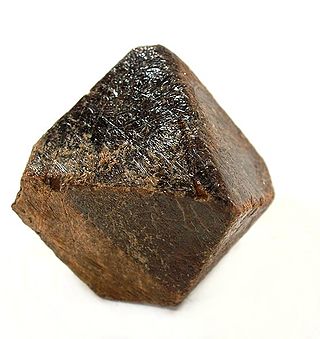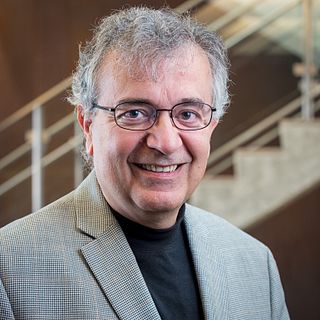
Manganese is a chemical element; it has symbol Mn and atomic number 25. It is a hard, brittle, silvery metal, often found in minerals in combination with iron. Manganese was first isolated in the 1770s. It is a transition metal with a multifaceted array of industrial alloy uses, particularly in stainless steels. It improves strength, workability, and resistance to wear. Manganese oxide is used as an oxidising agent; as a rubber additive; and in glass making, fertilisers, and ceramics. Manganese sulfate can be used as a fungicide.

Pyrochlore2Nb2O6(OH,F) is a mineral group of the niobium end member of the pyrochlore supergroup. Pyrochlore is also a term for the crystal structure Fd3m. The name is from the Greek πῦρ, fire, and χλωρός, green because it typically turns green on ignition in classic blowpipe analysis.
Colossal magnetoresistance (CMR) is a property of some materials, mostly manganese-based perovskite oxides, that enables them to dramatically change their electrical resistance in the presence of a magnetic field. The magnetoresistance of conventional materials enables changes in resistance of up to 5%, but materials featuring CMR may demonstrate resistance changes by orders of magnitude.

Heusler compounds are magnetic intermetallics with face-centered cubic crystal structure and a composition of XYZ (half-Heuslers) or X2YZ (full-Heuslers), where X and Y are transition metals and Z is in the p-block. The term derives from the name of German mining engineer and chemist Friedrich Heusler, who studied such a compound (Cu2MnAl) in 1903. Many of these compounds exhibit properties relevant to spintronics, such as magnetoresistance, variations of the Hall effect, ferro-, antiferro-, and ferrimagnetism, half- and semimetallicity, semiconductivity with spin filter ability, superconductivity, topological band structure and are actively studied as thermoelectric materials. Their magnetism results from a double-exchange mechanism between neighboring magnetic ions. Manganese, which sits at the body centers of the cubic structure, was the magnetic ion in the first Heusler compound discovered. (See the Bethe–Slater curve for details of why this happens.)

Oregon State University's College of Science is a public academic institution operating as a member of Oregon State University, a public research university. The college of science consists of seven schools, offering nine undergraduate programs and supporting seven doctoral-granting programs and eight master's degree-granting programs. The college also supports the science discipline colleges and bachelor of science students by offering key undergraduate science courses required by their own curriculums. The college of science claims more than 3,400 students and a faculty of 184. Sixteen faculty members are elected American Association for the Advancement of Science (AAAS) fellows.

Sir Anthony Kevin Cheetham is a British materials scientist. From 2012 to 2017 he was Vice-President and Treasurer of the Royal Society.

Calcium copper titanate (also abbreviated CCTO, for calcium copper titanium oxide) is an inorganic compound with the formula CaCu3Ti4O12. It is noteworthy for its extremely large dielectric constant (effective relative permittivity) of over 10,000 at room temperature.
Claudia Felser is a German solid state chemist and materials scientist. She is currently a director of the Max Planck Institute for Chemical Physics of Solids. Felser was elected as a member into the National Academy of Engineering in 2020 for the prediction and discovery of engineered quantum materials ranging from Heusler compounds to topological insulators.
Douglas A. Keszler is a distinguished professor in the Department of Chemistry at Oregon State University, adjunct professor in the Physics Department at OSU and adjunct professor in the Department of Chemistry at University of Oregon. He is also the director of the Center for Sustainable Materials Chemistry, and a member of the Oregon Nanoscience and Microtechnologies Institute (ONAMI) leadership team.

YInMn Blue, also known as Oregon Blue or Mas Blue, is an inorganic blue pigment that was discovered by Mas Subramanian and his (then) graduate student, Andrew Smith, at Oregon State University in 2009. The pigment is noteworthy for its vibrant, near-perfect blue color and unusually high NIR reflectance. The chemical compound has a unique crystal structure in which trivalent manganese ions in the trigonal bipyramidal coordination are responsible for the observed intense blue color. Since the initial discovery, the fundamental principles of colour science have been explored extensively by the Subramanian research team at Oregon State University, resulting in a wide range of rationally designed novel green, purple, and orange pigments, all through intentional addition of a chromophore in the trigonal bipyramidal coordination environment.

Mercouri Kanatzidis is a Charles E. and Emma H. Morrison Professor of chemistry and professor of materials science and engineering at Northwestern University and Senior Scientist at Argonne National Laboratory.
Gerald Dennis Mahan was an American condensed matter physicist, with specific research interests in transport and optical properties of materials, and solid-state devices. He is recognized for his work in quantum thermoelectricity and the invention of the zinc oxide varistor. He is also developed the time-dependent local-density approximation (TDLDA) and its author of various books in quantum many-body physics.

Joseph P. Heremans is a condensed matter experimental physicist at The Ohio State University where he holds titles as Ohio Eminent Scholar and Professor in the Department of Mechanical and Aerospace Engineering, with courtesy appointments in the Department of Physics and Department of Materials Science and Engineering. He is a member of the National Academy of Engineering and fellow of the American Physical Society and the American Association for the Advancement of Science. His research focuses on magneto-transport, thermal, and thermoelectric properties of electrons, phonons, and spin in narrow-gap semiconductors, semimetals, and nanostructures. Prior to OSU, Heremans worked as a research scientist and research manager at GM Research Lab from 1984-1998 and the Delphi Research Labs (1999-2005), where he developed tunable IR diode lasers and magnetic sensors.
Susan M. Kauzlarich is an American chemist and is presently a distinguished professor of chemistry at the University of California, Davis. At UC Davis, Kauzlarich leads a research group focused on the synthesis and characterization of Zintl phases and nanoclusters with applications in the fields of thermoelectric materials, magnetic resonance imaging, energy storage, opto-electronics, and drug delivery. Kauzlarich has published over 250 peer-reviewed publications and has been awarded several patents. In 2009, Kauzlarich received the annual Presidential Award for Excellence in Science, Mathematics and Engineering Mentoring, which is administered by the National Science Foundation to acknowledge faculty members who raise the membership of minorities, women and disabled students in the science and engineering fields. In January 2022 she became Deputy Editor for the scientific journal, Science Advances. She gave the Edward Herbert Boomer Memorial Lecture of the University of Alberta in 2023.
Bernard Raveau, born in 1940, is a French researcher in materials science, professor emeritus at the University of Caen Normandy, member of the French Academy of sciences.
Robert Day Shannon is a retired research chemist formerly at DuPont de Nemours, Inc.

Blue pigments are natural or synthetic materials, traditionally made from minerals, Being water-insoluble by definition, blue pigments used to make the blue colors in inks and paints. Some major blue pigments are indigo, Prussian blue, and copper phthalocyanine. Historically lapis lazuli was important.

Thomas Vogt is a German chemist and material scientist. He is an Educational Foundation Distinguished Professor in the Department of Chemistry and Biochemistry at the University of South Carolina.
Ram Seshadri is an American materials scientist, chemist and academic. He is the associate dean for research in the College of Engineering as well as distinguished professor in the Materials Department and the Department of Chemistry and Biochemistry, and the Fred and Linda R. Wudl Professor of Materials Science at University of California, Santa Barbara.











